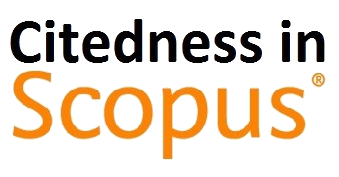Implementation of Simple Additive Weighting to Determine Priority for Handling Customer Complaints
(1) Information Systems Department, Faculty of Computer Science, Universitas Mercu Buana
(2) Information Systems Department, Faculty of Computer Science, Universitas Mercu Buana
(*) Corresponding Author
Abstract
The number of population is increasing, and the competition is getting tougher. It requires companies to remain able to survive and be able to compete with other companies, especially with companies that have the same line of business. The increasing use of the internet today has caused many changes in various fields. Many efforts are made by the company to survive, including by providing the best service to its customers. The use of existing technology for developing information systems for handling customer complaints is expected to help companies improve the quality of their products or services. In company management, it is important to provide good quality service in order to increase customer satisfaction. By determining the priority for handling customer complaints, it is expected to improve the Key Performance Indicator (KPI) of engineers. The decision-making process using the simple additive weighting method is carried out by weighting each criterion. This research is expected to determine the priority of handling customer complaints so that it can help engineers in determining the priorities for handling existing complaints.
Full Text:
PDFReferences
D. Firdaus, B. Priambodo, and Y. Jumaryadi, “Implementation of Push Notification for Business Incubator,” Int. J. Online Biomed. Eng., vol. 15, no. 14, pp. 42–53, 2019.
M. K. Qteishat, H. H. Alshibly, and M. A. Al-ma’aitah, “The impact of e-ticketing technique on customer satisfaction: an empirical analysis,” J. Inf. Syst. Technol. Manag., vol. 11, no. 3, pp. 519–532, 2014, doi: 10.4301/s1807-17752014000300001.
A. H. Wilarto and U. Salamah, “Sistem Penentuan Penerima Shodaqo Menggunakan Metode Simple Additive Weighting,” JUST IT J. Sist. Informasi, Teknol. Inf. dan Komput., vol. 10, no. 2, pp. 123–128, 2020.
W. Gunawan and M. R. Firmansyah, “Monitoring dan Evaluasi Kinerja Karyawan menggunakan Algoritma Simple Additive Weighting dan Hungarian,” Ilk. J. Ilm., vol. 12, no. 2, pp. 87–95, 2020, doi: 10.33096/ilkom.v12i2.519.87-95.
Y. Jumaryadi, D. Firdaus, B. Priambodo, and Z. P. Putra, “Determining the Best Graduation Using Fuzzy AHP,” 2020 2nd Int. Conf. Broadband Commun. Wirel. Sensors Powering, BCWSP 2020, pp. 59–63, 2020, doi: 10.1109/BCWSP50066.2020.9249463.
A. Filip, “Complaint Management: A Customer Satisfaction Learning Process,” Procedia - Soc. Behav. Sci., vol. 93, pp. 271–275, 2013, doi: 10.1016/j.sbspro.2013.09.188.
P. Williams and E. Naumann, “Customer satisfaction and business performance: A firm-level analysis,” J. Serv. Mark., vol. 25, no. 1, pp. 20–32, 2011, doi: 10.1108/08876041111107032.
Yogi Hermawan, . D., and Yessy Yanitasari, “Penentuan Peluang Usaha Pertanian Holtikultura Menggunakan Simple Additive Weighting dan Promethee,” J. RESTI (Rekayasa Sist. dan Teknol. Informasi), vol. 3, no. 3, pp. 422–428, 2019, doi: 10.29207/resti.v3i3.1255.
M. Nashar, A. Sukamto, and R. D. Parashakti, “Sistem Penunjang Keputusan (Decision Support System DSS) Untuk Pemilihan Karyawan Berprestasi Dengan Metode Simple Additive Weighting (Studi Kasus di Akademi Telekomunikasi Bogor),” J. Ilm. Manaj. dan Bisnis, vol. 2, no. 3, pp. 882–891, 2016.
R. S. Hutasoit, A. P. Windarto, D. Hartama, and Solikhun, “Sistem Pendukung Keputusan Pemilihan Guru Terbaik Pada SMK Maria Goretti Pematangsiantar Menggunakan Metode Simple Additive Weighting (SAW),” Jurasik (Jurnal Ris. Sist. Inf. dan Tek. Inform., vol. 1, no. 1, pp. 56–63, 2016, doi: 10.30645/jurasik.v1i1.9.
DOI: https://doi.org/10.30645/ijistech.v5i1.110
Refbacks
- There are currently no refbacks.
Jumlah Kunjungan:
Published Papers Indexed/Abstracted By:












